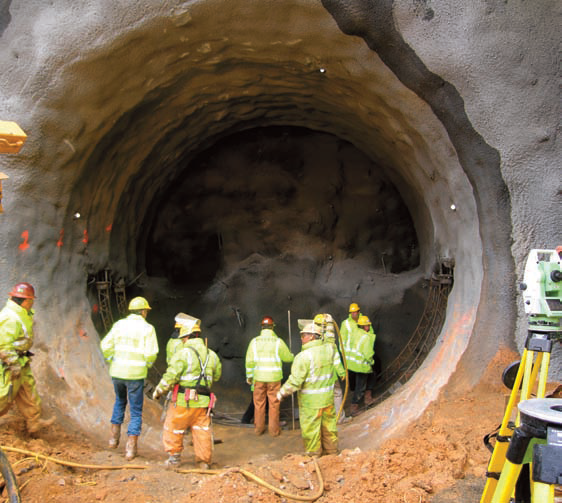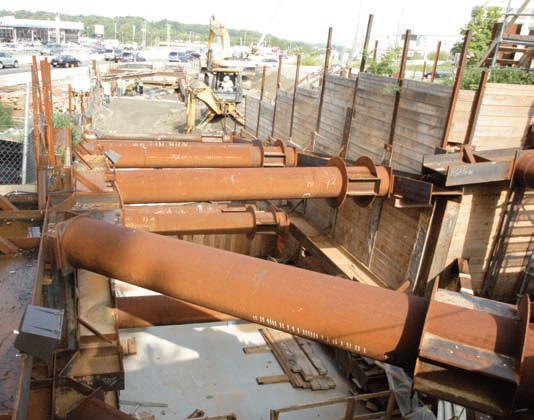
initial construction of a tunnel at Tysons
Source: Dulles Corridor Metrorail Project, Tunnel Construction Continues in Tysons Corner

initial construction of a tunnel at Tysons
Source: Dulles Corridor Metrorail Project, Tunnel Construction Continues in Tysons Corner
For the Silver Line, the Washington Metropolitan Airports Authority carved a short tunnel at Tysons. There is one tube for each track between the Tysons Corner and Greensboro stations.
The Washington Metropolitan Airports Authority was given control over the Dulles Toll Road and its revenues, plus responsibility for constructing the Silver Line, in 2006. Dulles Transit Partners had already been selected the contractor responsible for the design-build project.
Just one day prior to the transfer of authority, Dulles Transit Partners declared that the initial plans for 3.4-mile long tunnel would cost $500 million more than an alternative that would place most of the Silver Line on Aerial structures rather than underground. Virginia's Secretary of Transportation created an independent Dulles Metrorail Tunnel Review Panel, which concluded that a tunnel would cost $250 million more but last 120 years compared to the 60 years for the aerial alternative.1
That led to a public push by the Greater McLean Chamber of Commerce to reconsider the decision to build bridges through Tysons, using the phrase "It's not over till it's under." Advocates for a much longer tunnel raised $3.5 million and funded a new engineering study for using large-diameter tunnel boring machines.
The primary goal was to build four underground stations and minimize unsightly elevated tracks. Those would limit the potential for Tysons to evolve into an esthetically attractive, walkable urban center with higher property values. Virginia officials finally concluded that the extra $500 million cost for a long tunnel, exceeding cost estimates, would result in a loss of $900 million in Federal funding for the project.2
The twin 2,400-foot-long tunnels at Tysons were constructed primarily by using the New Austrian Tunneling Method, also known a the Sequential Excavation Method (SEM). The cut-and-cover approach, where a trench is excavated first and then tunnel walls are constructed before re-filling the trench, was used for the portals at each end. Many of the 70-member construction crew had recent experience, having helped to build the AeroTrain tunnels at Dulles International Airport.

cut-and-cover technique was used on the west end of the Tyson tunnels
Source: Dulles Corridor Metrorail Project, Tunnel Construction Continues in Tysons Corner
There were Coastal Plain sediments above the Piedmont bedrock (metamorphic schist) at Tysons. The 515-foot high summit at Tysons was described by one company:3
The New Austrian Tunneling Method required close monitoring of soil conditions and rapid spraying of shotcrete to stabilize the tunnel walls as they were excavated. A specialized drill installed pipe and created an arched roof in advance of excavation. The tunneling method did not require use of an expensive tunnel boring machine for the short tunnel distance, and offered the same advantage of minimizing disruptions which would have been caused by cut-and-cover at the Route 7 and Route 123 interchange.
Silver Line rails avoided the Capital Beltway by going 55' high above the traffic. Underneath the surface west of the bridge over the interstate highway, choosing a path was not a simple exercise. For the Silver Line construction at Tysons, 75 miles of conduit with cables owned by 21 private utilities had to be moved. The engineer responsible for tunneling at Tysons described the complications, including a fiber-optic line to the Federal government's microwave communications tower on top of the hill at Tysons transmitting top-secret ("black") data:4